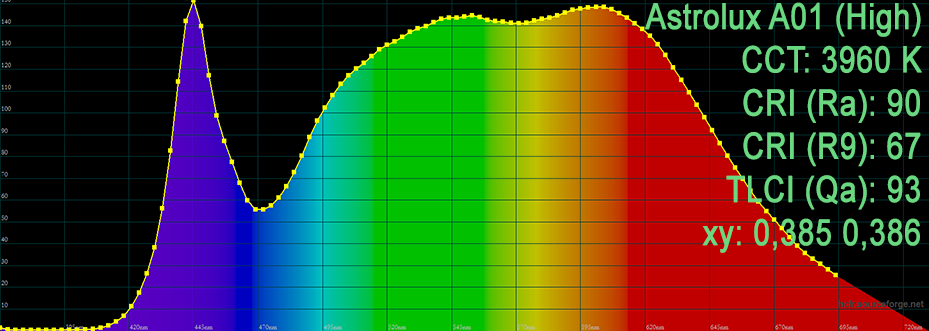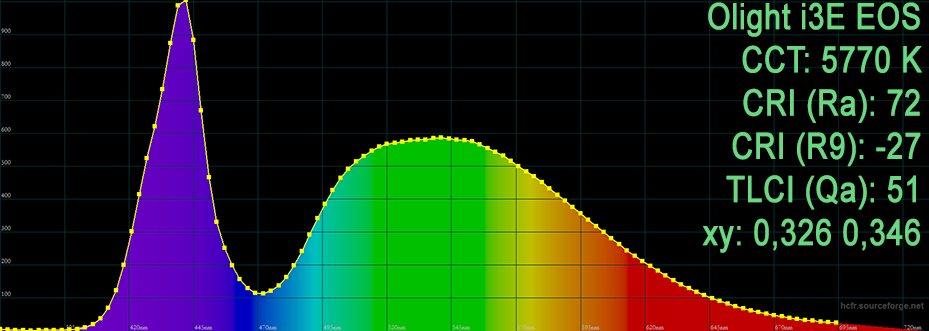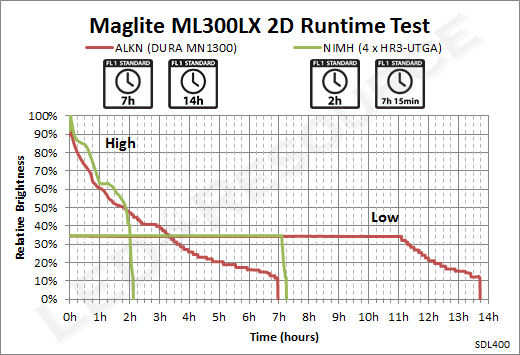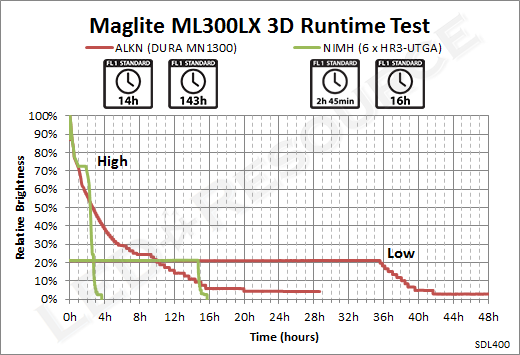The manufacturer states Nichia 219C. Even though this spec might not be fully true, in the remainder of the review i am going to employ this spec'ed detail when referring to the emitter.
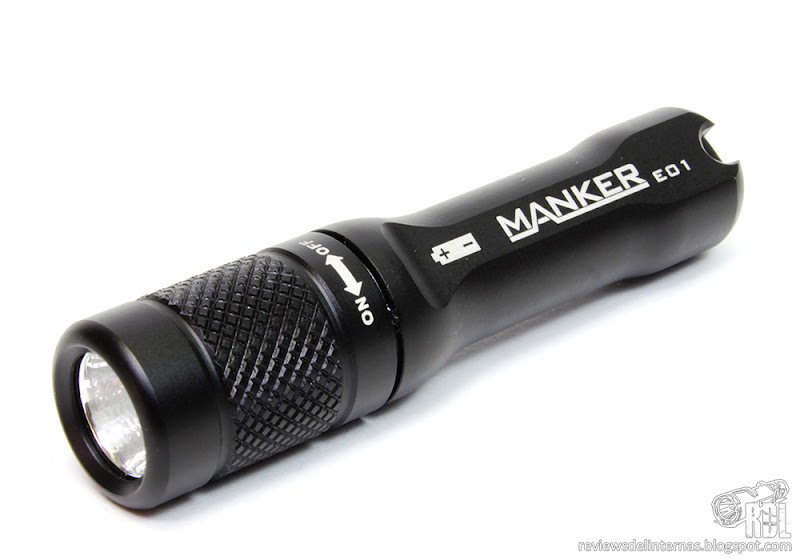
MANKER E01
LED: Nichia 219C
Battery: 1x AAA
Modes: 4 (Low-Med-High-Strobe)
Switch: Twisty
Date: March 2016
INTRODUCTION:
The Manker E01 is a simple and small flashlight from this new manufacturer, which it looks like we're talking about a lot lately. Like any self-respecting brand, Manker now offers an "introductory" small and inexpensive flashlight, intended for everyday use or key ring. It is available in various colors. This flashlight is also marketed under the brand Astrolux, which can lead to some misunderstandings.
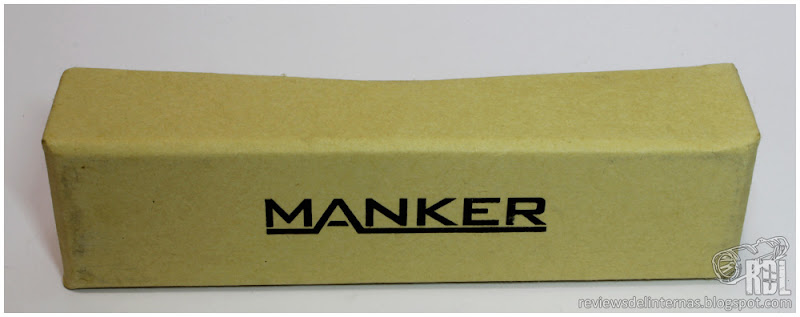

The product presentation is very similar to what we have seen in other flashlights from this manufacturer, with a small cardboard box in which we find the flashlight accompanied a spare o-ring and a small split-ring for the keychain. It also includes an user manual in two languages (Chinese-English).
EXTERNAL FINISH:
The exterior design of this flashlight is quite original, because of its rounded shapes and slight oversizing gives it a very own distinctive aspect.

It is machined in anodized aluminum with very nice matte finish, and has some very well-defined and easy to read engravings thanks to the high contrast obtained between the black background and white graphic. In addition to the brand and model, we have an indication with the correct polarity of the battery as well as another indication of the mode of use, all very basic.
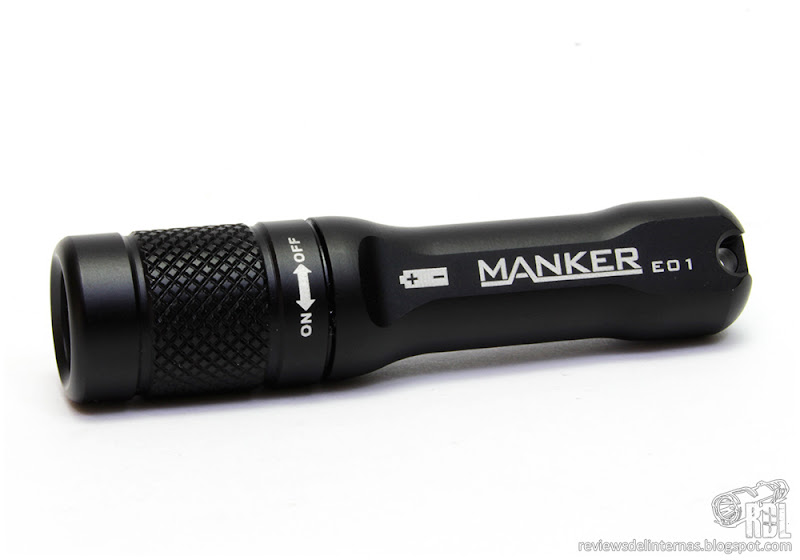
The head of the flashlight has substantially larger diameter than the rest of it, and has a generous strip of knurling which greatly facilitates the grip of the head to make use of the twisty. The bezel is flat, with generously rounded edges.
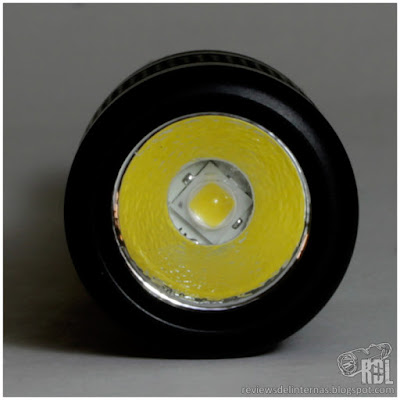
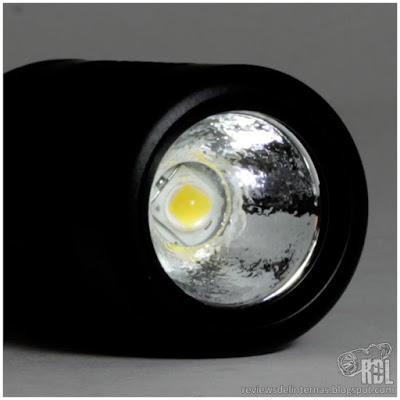
The optics of this small Manker is composed by a OP reflector and Nichia 219 LED with neutral tint, properly centered, and all topped off with an AR coated glass lens.
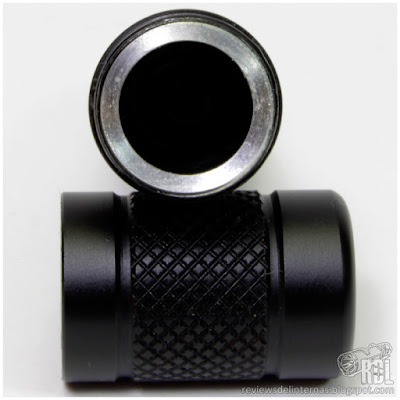

The walls of the flashlight, especially in its connection between the head and body have a very generous thick. The driver disk is covered by a foam ring, which prevents the typical battery rattle when the flashlight is off, and in addition it also works as a mechanical protection system against wrongly installed battery (reverse polarity).


The threads are anodized, and arrive well bathed in lubricant from factory, as well as the o-ring. Twisty action is quite smooth.
The tube design is quite peculiar as it has "two volumes" but maintains a smooth design, with smooth curves at both ends. Tail design, also rounded, has a large hole to put the split ring. Machining surrounding it has some sharp angles. Of course, with a design so rounded the tailstand of this flashlight is stable at all.

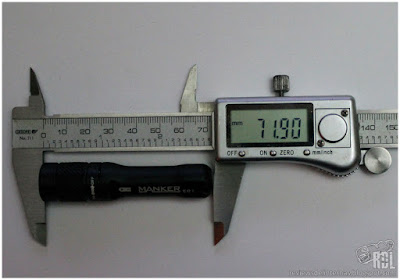

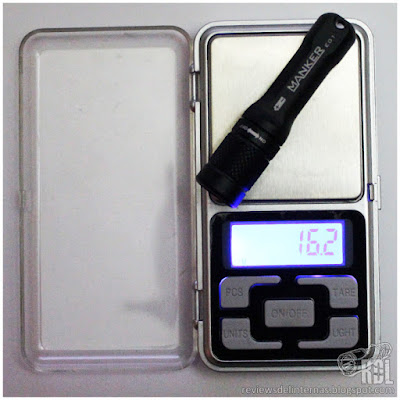
Dimensions and very similar to the average in this type of flashlights weight.
USER INTERFACE:
The E01 has a fairly simple user interface, common with many other popular AAA flashlights:

(All measurements are taken following the procedure ANSI NEMA FL1, taking as value the highest reading of between 30 and 120 seconds after activation. More details here.)
The three modes of this E01 are separated by great distances. In the user manual referred to as Low mode as Firefly, that with such sub-lumen mode like this that name would have been more appropriate. The Med mode, with 7LM is much more usable, and with maximum output mode we found a small discrepancy between measured by the sphere and specified by the manufacturer.
PERFORMANCE:
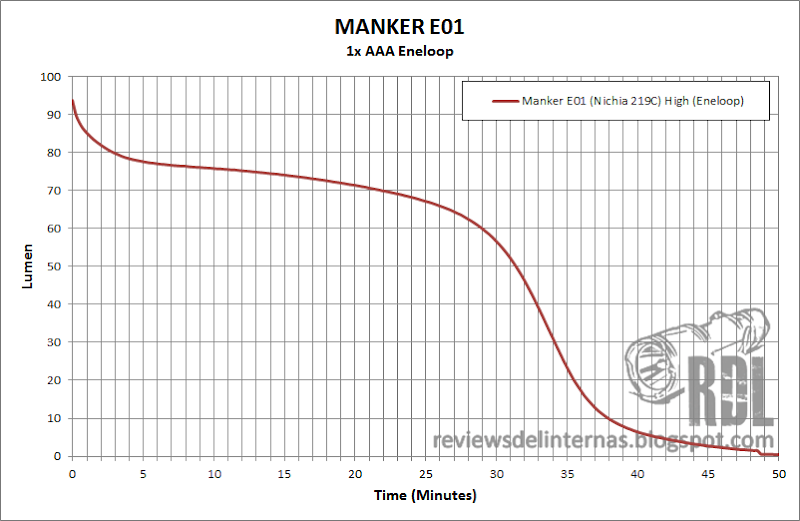
Performance in Hight mode with AAA Eneloop is quite discreet, with a smooth curve in which most of the time we move between 70 and 80LM.
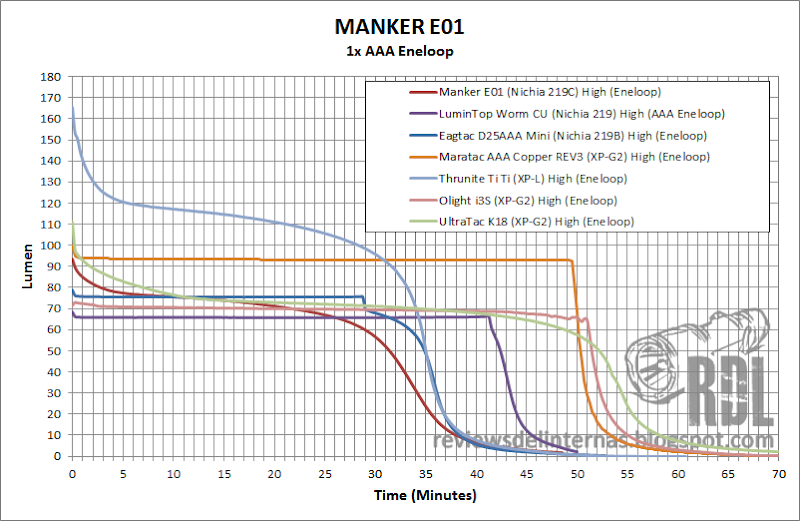
Compared to other flashlights AAA, this E01 is not particularly outstanding nor maximum output nor for runtime. Click here for a view the image in higher resolution.
EFFICIENCY:
In this new feature for my reviews I will analyze the efficiency of each flashlight in a fairly simple way. Taking advantage of the data obtained in the previous runtime vs output test, we can make an estimate of the efficiency in lm·h, which will give us a value equivalent to the area that the line of each flashlight delineates between the X and Y axis of a graph as the one from previous section of this review. Given that all compared flashlights have been tested under the same conditions, using a battery of the same model and the same measuring instrument, we get the following result:
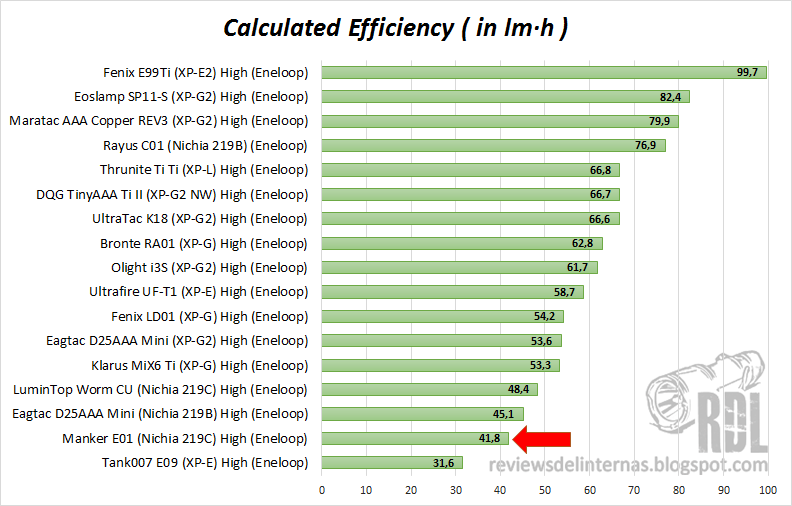
(More details of how this calculation was made here.)
We can see in this bar comparison chart how well each of the tested flashlights performs (in a given mode) in the task of converting the battery power into accumulated luminous flux. As expected, the flashlights with a lower regulated output mode, or with drastic stepdown such the E99Ti scores better lm·h results in such test as emitter efficiency is better in that lower output ranges.
In this particular case, the Manker E01 scores a fairly poor result, just above the old and outdated Tank007 E09.
BEAM PROFILE:
The Nichia 219 is undoubtedly the hottest point of this Manker, since it is difficult to see such emitter in a mass produced flashlight.




The projection is very good with a medium-large hotspot well faded with spill with no artifacts or darker areas in the area surrounding the corona.


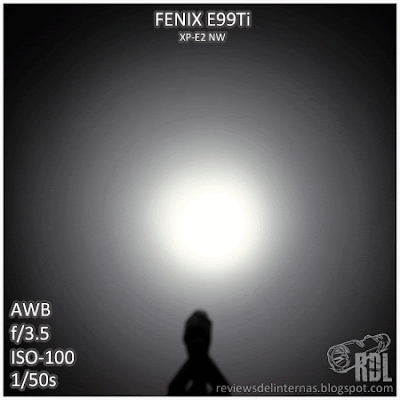

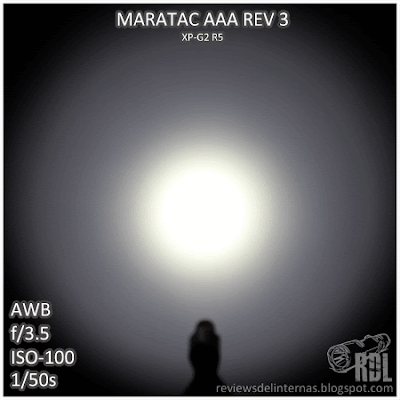
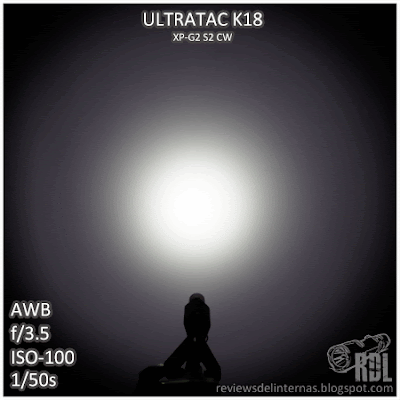
Although the Nichia LED is slightly behind at maximum output or efficiency versus CREE alternatives, such the XP-G2, the Japanese manufacturer Nichia emitter offers a higher CRI (Color Rendering Index), so it is able to reproduce illuminated colors in a more reliable way or closer as sunlight would do.
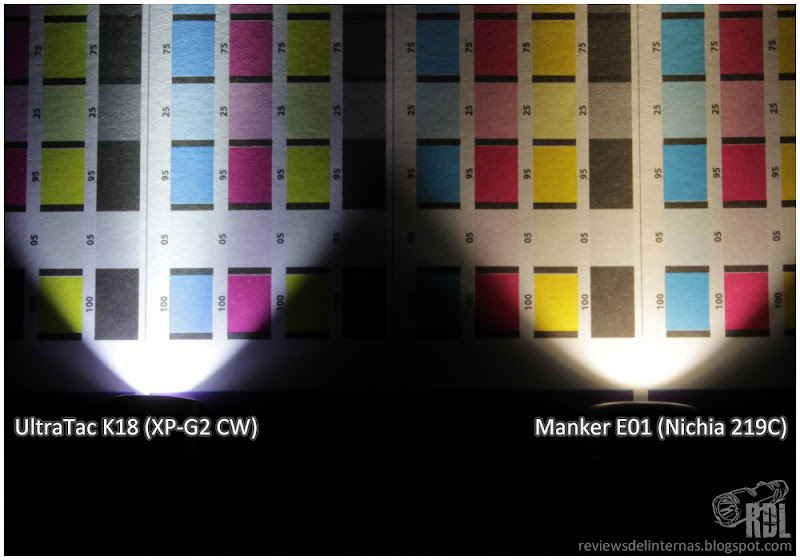
Camera WB: Daylight
PERSONAL CONCLUSION:
Although the flashlight has no special charm beyond the employ of a "gourmet" emitter, I must admit that for the price this is an excellent alternative for those looking for a neutral or high CRI flashlight simple, inexpensive and different from the rest in aesthetic design.
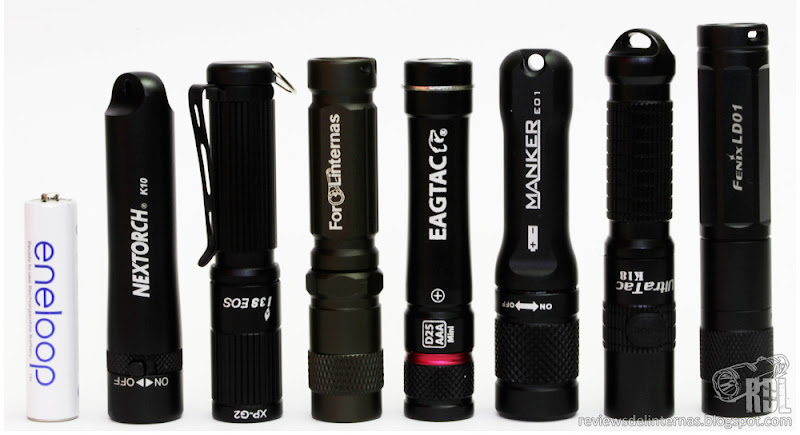

Nextorch K10 · Olight i3S EOS · Tank007 E09 · Eagletac D25AAA Mini · Manker E01 · Ultratac K18 · Fenix LD01
Negatives: The E01 is a slightly over-sized flashlight, with a head that is somewhat larger in diameter and perhaps wasted space. The performance and efficiency of its High mode is poor compared with other similar single AAA flashlights. The spacing of the modes is a bit quirky, and the default activation mode may be too low for most situations.
Positives: Undoubtedly the attractive price of this AAA flashlight is a good point, because it allows us to ponder its acquisition unceremoniously. The chosen LEDemitter is in my opinion another plus for Manker, because it offers us a great CRI, hard to find in mass produced flashlights and much less at this price.

MANKER E01
LED: Nichia 219C
Battery: 1x AAA
Modes: 4 (Low-Med-High-Strobe)
Switch: Twisty
Date: March 2016
INTRODUCTION:
The Manker E01 is a simple and small flashlight from this new manufacturer, which it looks like we're talking about a lot lately. Like any self-respecting brand, Manker now offers an "introductory" small and inexpensive flashlight, intended for everyday use or key ring. It is available in various colors. This flashlight is also marketed under the brand Astrolux, which can lead to some misunderstandings.


The product presentation is very similar to what we have seen in other flashlights from this manufacturer, with a small cardboard box in which we find the flashlight accompanied a spare o-ring and a small split-ring for the keychain. It also includes an user manual in two languages (Chinese-English).
EXTERNAL FINISH:
The exterior design of this flashlight is quite original, because of its rounded shapes and slight oversizing gives it a very own distinctive aspect.

It is machined in anodized aluminum with very nice matte finish, and has some very well-defined and easy to read engravings thanks to the high contrast obtained between the black background and white graphic. In addition to the brand and model, we have an indication with the correct polarity of the battery as well as another indication of the mode of use, all very basic.

The head of the flashlight has substantially larger diameter than the rest of it, and has a generous strip of knurling which greatly facilitates the grip of the head to make use of the twisty. The bezel is flat, with generously rounded edges.


The optics of this small Manker is composed by a OP reflector and Nichia 219 LED with neutral tint, properly centered, and all topped off with an AR coated glass lens.


The walls of the flashlight, especially in its connection between the head and body have a very generous thick. The driver disk is covered by a foam ring, which prevents the typical battery rattle when the flashlight is off, and in addition it also works as a mechanical protection system against wrongly installed battery (reverse polarity).


The threads are anodized, and arrive well bathed in lubricant from factory, as well as the o-ring. Twisty action is quite smooth.
The tube design is quite peculiar as it has "two volumes" but maintains a smooth design, with smooth curves at both ends. Tail design, also rounded, has a large hole to put the split ring. Machining surrounding it has some sharp angles. Of course, with a design so rounded the tailstand of this flashlight is stable at all.




Dimensions and very similar to the average in this type of flashlights weight.
USER INTERFACE:
The E01 has a fairly simple user interface, common with many other popular AAA flashlights:
- On and off: This small Manker E01 turns on and off by screwing or unscrewing of the head. With fully screwed head flashlight turns on, with head slightly unscrewed flashlight turns off.
- Changing Modes: To switch between modes we have to make a momentary off, to turn it on again in the successive 2 seconds. The order is ascending: L-> M-> H.
- Memory: E01 has no memory mode, so after ~10 seconds from off it always starts on default Low mode.
- Hidden strobe mode: To access the stroboscopic mode we must perform a sequence of six on / off (L-> M-> H-> L> M> H> Strobe).

(All measurements are taken following the procedure ANSI NEMA FL1, taking as value the highest reading of between 30 and 120 seconds after activation. More details here.)
The three modes of this E01 are separated by great distances. In the user manual referred to as Low mode as Firefly, that with such sub-lumen mode like this that name would have been more appropriate. The Med mode, with 7LM is much more usable, and with maximum output mode we found a small discrepancy between measured by the sphere and specified by the manufacturer.
PERFORMANCE:

Performance in Hight mode with AAA Eneloop is quite discreet, with a smooth curve in which most of the time we move between 70 and 80LM.

Compared to other flashlights AAA, this E01 is not particularly outstanding nor maximum output nor for runtime. Click here for a view the image in higher resolution.
EFFICIENCY:
In this new feature for my reviews I will analyze the efficiency of each flashlight in a fairly simple way. Taking advantage of the data obtained in the previous runtime vs output test, we can make an estimate of the efficiency in lm·h, which will give us a value equivalent to the area that the line of each flashlight delineates between the X and Y axis of a graph as the one from previous section of this review. Given that all compared flashlights have been tested under the same conditions, using a battery of the same model and the same measuring instrument, we get the following result:

(More details of how this calculation was made here.)
We can see in this bar comparison chart how well each of the tested flashlights performs (in a given mode) in the task of converting the battery power into accumulated luminous flux. As expected, the flashlights with a lower regulated output mode, or with drastic stepdown such the E99Ti scores better lm·h results in such test as emitter efficiency is better in that lower output ranges.
In this particular case, the Manker E01 scores a fairly poor result, just above the old and outdated Tank007 E09.
BEAM PROFILE:
The Nichia 219 is undoubtedly the hottest point of this Manker, since it is difficult to see such emitter in a mass produced flashlight.




The projection is very good with a medium-large hotspot well faded with spill with no artifacts or darker areas in the area surrounding the corona.






Although the Nichia LED is slightly behind at maximum output or efficiency versus CREE alternatives, such the XP-G2, the Japanese manufacturer Nichia emitter offers a higher CRI (Color Rendering Index), so it is able to reproduce illuminated colors in a more reliable way or closer as sunlight would do.

Camera WB: Daylight
PERSONAL CONCLUSION:
Although the flashlight has no special charm beyond the employ of a "gourmet" emitter, I must admit that for the price this is an excellent alternative for those looking for a neutral or high CRI flashlight simple, inexpensive and different from the rest in aesthetic design.


Nextorch K10 · Olight i3S EOS · Tank007 E09 · Eagletac D25AAA Mini · Manker E01 · Ultratac K18 · Fenix LD01
Negatives: The E01 is a slightly over-sized flashlight, with a head that is somewhat larger in diameter and perhaps wasted space. The performance and efficiency of its High mode is poor compared with other similar single AAA flashlights. The spacing of the modes is a bit quirky, and the default activation mode may be too low for most situations.
Positives: Undoubtedly the attractive price of this AAA flashlight is a good point, because it allows us to ponder its acquisition unceremoniously. The chosen LEDemitter is in my opinion another plus for Manker, because it offers us a great CRI, hard to find in mass produced flashlights and much less at this price.
Manker E01 provided by manufacturer for review.
Last edited by a moderator:


